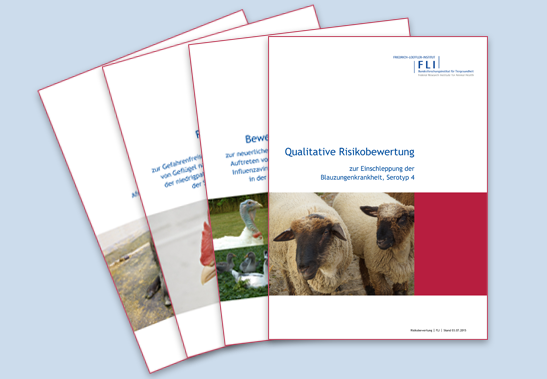Qualitative risk assessment for seasonal transmission of bluetongue virus and its spread by movements of ruminants from restriction zones
After many years of freedom from bluetongue disease, new cases of infections with Serotype 8 occurred in cattle in the southwest of Germany at the end of 2018. Therefor the FLI updated the risk assessment regarding the seasonal transmission of bluetongue virus by biting midges and the risk of spread of bluetongue virus by movements of ruminants from restriction zones.
With regard to seasonal transmission through biting midges, the risk was assessed as negligible for the months December to March (low vector-active period), moderate for April and November and high for May to October (vector-active period). The risk may vary between different regions of Germany.
There is, in principle, a risk of virus spread by movements of animals carrying replicating virus (viraemic animals) or cows that are pregnant with viraemic fetuses to free areas. However, the Bluetongue disease (BT) virus can only spread if living vectors are active. To mitigate this risk, national and European regulations (Commission Regulation (EG) No 1266/2007) for animal movements exist.
During the vector-free period, the EU regulations impose certain time limits or combinations of examiniations and waiting periods to avoid movements of viraemic animals that were infected at the end of the vector-active period. Within the vector-active period, animal movements are only allowed if there is proof of vaccination or if antibodies can be detected. For this reason, the risk of spread by movements of animals according to regulation EG No 1266/2007 is estimated as negligible.
Regarding national regulations
(1) the risk of spread by movements of animals for slaughter or movements of animals with sufficient vaccination is estimated also as negligible both within the low vector-active period and the vector-active period.
(2) the risk of spread by movements of infected calves to free zones is estimated as low both within the low vector-active and the vector-active period for two reasons. During the last months an increasing number of viraemic calves has been observed, which allows an undetected spread of the virus. Due to the nine-month gestation period, an intrauterine infection might lead to viraemic calves being born virtually all year round.
(3) the risk of spread by movements of animals tested virologically negative in combination with a protection against biting midges is estimated as probable within the vector-active period (due of possible infections between testing and movement and because of the esteemed insufficient repellent effect), and as negligible within the low vector-active period.


